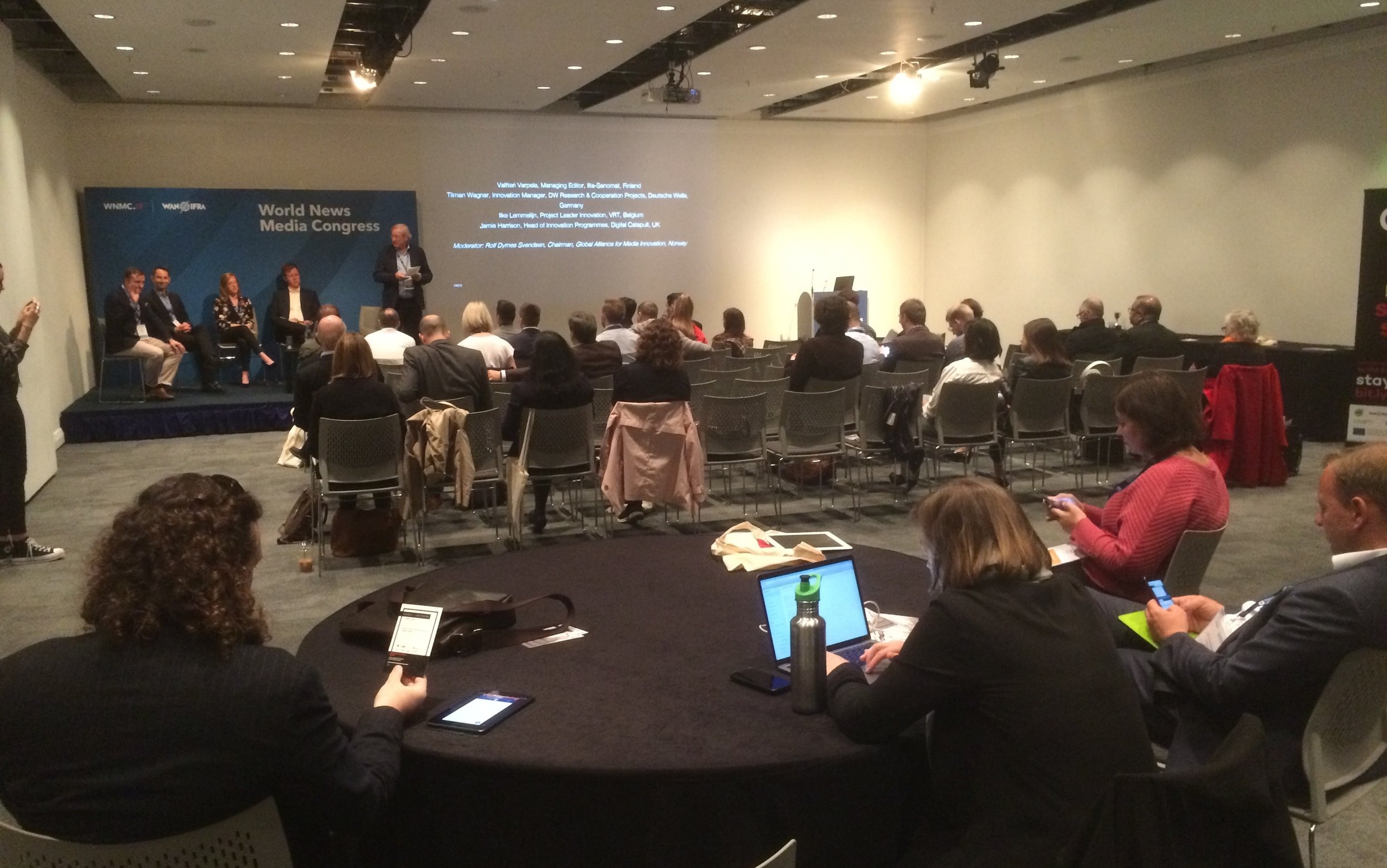Rebuilding audience’s trust in algorithms: personalisation at the World News Media Congress 2019
/How are newspapers currently approaching content personalisation? Could it open new ways for publishers to build stronger relationships with their audiences? How can tech startups support the news industry in exploring the benefits of personalisation?
These and many other questions were explored at the session “Personalisation of news matters!“ at the World News Media Congress 2019.
‘We want to offer the best front page to everyone’
Valtteri Varpela, managing editor at Ilta-Sanomat, kicked things off with a presentation on how the Finnish newspaper currently uses personalisation on its homepage. The evening tabloid has an exceptionally strong online presence in Finland, with its website boasting 3,6 million unique monthly visitors. (For reference, Finland has a population of 5,5 million.).
However, among the newspaper’s vast audience there are naturally various kinds of news consumers, and each represents a different kind of challenge.
“We publish about 170 articles a day, and people who read our website once a day will miss a massive amount of that content,” Varpela said. “On the other hand the heavy-users, who may check the website up to 30 times a day, may run out of new content during the day.”
“Our aim with personalisation is to offer a website that serves all types of readers. Instead of presenting the same front page to different kinds of users, we want to offer the best front page to everyone.”
Ilta-Sanomat believes that personalisation will unlock the third era of online news consumption.
More broadly, Varpela said Ilta-Sanomat sees personalisation as the next major step in the evolution of digital news publishing. Online news first took off on desktop, while mobile has since become the leading platform for digital news.
“But we think that we have now reached the peak with mobile. The next step will be a move towards personalised news feeds.”
Bursting the filter bubble
While personalisation algorithms are becoming more and more common in the news media, many worry about the so-called filter bubble effect – that algorithms end up displaying audiences only articles that correspond with their taste and preferences, causing them to miss out on other important content.
Ilta-Sanomat addresses this by making sure that their algorithm not only relies on users’ profiles but also takes into account editorial judgement in how the articles are placed on the page. Moreover, the top articles on the page are the same for every user, and the article list includes specific “Exploration modules”, which ensure that readers are also exposed to articles that don’t match their preferences.
Ilta-Sanomat uses various types of modules on its personalised home page.
According to Varpela, the newspaper’s personalisation efforts have been a clear success: pageviews have not only gone up, but they are spread more widely across different sections and different types of stories than before. Moreover, heavy users are now seeing more stories, while others are getting more relevant content.
“In short, we have become a better news service.”
Rebuilding trust through transparency
Next, Tilman Wagner, innovation manager at Deutsche Welle, gave a description of the Content Personalisation Network (CPN), which aims to build an industry-leading personalisation solution for the news media (check out our vision here).
Wagner emphasised that as personalisation algorithms increasingly define what news content audiences are exposed to, it’s becoming crucial that the news media addresses related questions around data control, openness of algorithms, and transparency. As a research project CPN looks closely at these issues, especially transparency.
CPN aims to explore and learn about a wide range of topics related to content personalisation.
“Social networks and particularly Facebook’s News Feed have given algorithmic personalisation a bad name, since users don’t exactly know how they function,” said Wagner. “We want to bring more transparency into the equation. We believe that it will help rebuild audiences' trust in personalisation.”
Although several publishers have started to offer personalised content, the ways in which the different recommender systems work can vary greatly. “No one has the perfect algorithm, but what we try to do with CPN is experiment with mixing different approaches, and see if we can at least get closer to the right formula.”
Curation vs. personalisation
The panel discussion that followed the presentations expanded on the theme of editorial judgement, and why it should be incorporated into news recommender systems.
“During our research, we found that curation was an important reason why people came to specific publishers. They put their trust in editors, and expected them to choose the content that is relevant to their readers,” said Jamie Harrison, head of innovation programmes at Digital Catapult, one of the partners in the CPN project.
“Among publishers, there was a clear concern that if you put your content in the hands of a machine, you might lose some brand value.”
The panelists (left to right): Valtteri Varpela, Tilman Wagner, Ilke Lemmelijn and Jamie Harrison, with the moderator Rolf Dyrnes Svendsen.
Regarding the filter bubble issue, the CPN recommender aims to address this by displaying a mixture of personalised and selected content. This ensures that users see the content that the publisher doesn’t want them to miss, said Ilke Lemmelijn, who is an innovation project leader at VRT, another CPN partner.
“Transparency is also crucial here: it’s very important to communicate to users why they see what they see.”
Start-up pitches
The session came to a conclusion with pitches from startups that are working with the CPN team. The following companies are developing innovative solutions that will expand the functionalities of the CPN platform.
We’ll soon publish more information about these startups and their work with CPN. In the meantime, check out these tweets to read more about their pitches:
The first startup pitch is from Kensai: @WillCrosthwait describes how the company’s AI-powered dashboard gives news publishers tools to get detailed real-time feedback about their content. #WNMC19 pic.twitter.com/xPfSMG3cOS
— projectCPN (@project_cpn) June 2, 2019
@LoomiAssistan presents https://t.co/wNKizrL6B1 and how the company is creating a “general news ontology” solution, which aims to provide an automated tagging system that also analyses how entities in different articles relate to one another. #WNMC19 pic.twitter.com/HpB0iq4IuO
— projectCPN (@project_cpn) June 2, 2019
Stavria K. Konstantinou presents Tapoi, a service built by @uhopper, which analyses users’ social media activity to address the so-called “cold start” and filter bubble problems related to personalisation #WNMC19 pic.twitter.com/OliptdDgbj
— projectCPN (@project_cpn) June 2, 2019
Finally, @MattiaFosci pitches Yoop’s IDWard, a product for creating a unified sign-in and aggregating user data across devices while protecting privacy using E2E encryption and blockchain #WNMC19 pic.twitter.com/VUECyXa49K
— projectCPN (@project_cpn) June 2, 2019
Our jury chose Yoop as the most promising startup!
The jury has decided that the Most Promising Startup is… Yoop!
— projectCPN (@project_cpn) June 2, 2019
Congratulations to the winner! 🥂🏆
And a Big Thank You to all of the participants! #WNMC19 pic.twitter.com/3LIIJEw07h
Congratulations to Yoop! You’ll soon be able to read about it, as well as the other startups, on the CPN blog.
By Teemu Henriksson











